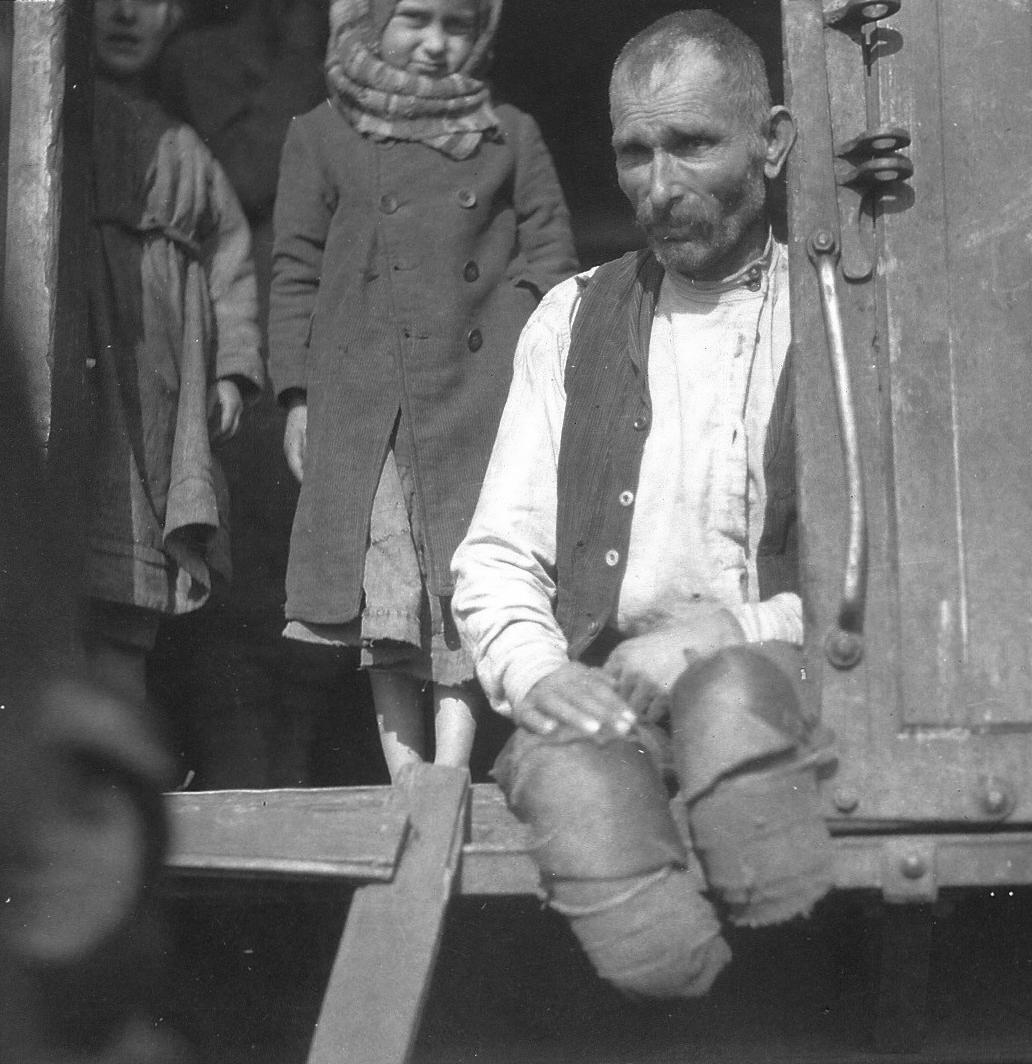
Russian Civil War Foreign Interventions: United States in Vladivostok (1918-20)

Figure 1.--We believe yjis is a photograph taken during the Russian Civil War showing refugees in Vladivostok. The American Red Cross Mission in Siberia was in Vladivostok during 1919 to assist in the care of thousands of refugees who had amassed there. Fleeing the fierce fighting of the Russian Civil War. Large groups throughout the former Tsarist empire had escaped eastward on the Trans-Siberian Railroad, spilling into the eastern terminus at Vladivostok.
When the Bolshevik revolution began in Petrograd (St. Petersburg) some 1,000 children were evacuated from that city. They were placed by their parents on the Trans-Siberian railroad in the hopes they would reach safety in Siberia. They traveled for two weeks, over 2,000 miles, finally arriving at the terminus of the railway, in Vladivostok, where the Red Cross workers took them under their wing. Here a legless man sits in the door of the boxcar and children can be seen inside the box car. These chilling, original photos offer a glimpse of this horrible period in time, and show the faces of the men, women and children who suffered through it. This is just one instances of the millions of Russians, especially children, saved by the United States in the 20th century. And would have saved millions more if Stalin had not kept the Ukranian famine he engineered a secert. Incredibly, President Putin is today preventing Russian orphans, unwanted in their own country, from obtaining loving homes in America. Source: American Red Cross.
|
|
President Wilson ordered an American Expeditionary Force (AEF-Siberia) to land at Vladivostok (August 1918). The purpose of the landings is not all together clear, but appear to be as much diplomatic as military. There were supplies that had been landed there to support the Russian war effort against Germany. Concern about Japanese intentions may have been even more important. Another concern was the Czech Legion, about 40,000 Czech and Slovak men that were loyal to a planned independent Czechoslovakia which meant the Allies. They were originlly conscripted by Austria-Hungary and taken as POWs taken by the Tsarist Army, but who after the Russian Revolution had seized arms and were trying to get home. The United States was not only sympathetic to nationalist aspirations (in part because of the immigrant population), but also because there was a possibility of redeploying them on the Western Front. The direct path west was blocked by the Bolsheciks. So they decided to transit the Trans-Siberian Railway and return hime via Vladivostok. The Czechs had to fight both the Reds ad Whites to get to Vladisvostok. Wilson was also interested in protecting the substantial quantities of military supplies and railroad rolling stock that the United States had delivered to Vladisvodtok to support the Russian war effort before the Bolsheciks has taken Russia out of the War. Bolshevik forces at the time did not yet control Siberia, although they held small pockets. Wilson wanted to keep the supplies out of their hands as make sure that neither Cossack or the Japanese seized the supplies or the Trand-Siberian Railway. The AEF-Siberia was commanded by Major General William S. Graves. AEF Siberia would eventually total 7,950 men. It was made up of the U.S. Army's 27th and 31st Infantry Regiments, plus volunteers from the 13th Infantry Regiment. Also involved was the 62nd Infantry Regiments along with a snall contingent from the 12th Infantry Regiment. The AEF-Siberia was armed with the standard issue M1903 Springfield rifle, M1918 Browning Automatic Rifles (BAR), and M1911 .45 caliber pistols. They did not have heavy weapons. The first 3,000 American troops landed in Vladivostok (August 15-21). They took up positions along the Trans-Siberian Railway between Vladivostok and Nikolsk-Ussuriski in the north. General Graves arrived 2 weeks later (September 4). General Graves was focused on protecting American-supplied property and to assist the Czechoslovak Legion get out of Russia. He did not order any offensive actions against the Blosheviks, although there were a number of small-scale actions. The Allies (Britain and France) and the Japanese, who also landed forces, wanted a more aggressive stance toward the Bolsheviks. The U.S. troops guarded the Trans-Siberian Railway from Baikal to Vladivostok. Navy ships and shore parties defended the port. The American forces did not enter the battles between the Whites and Reds, but did return fire if attacked. Conditions for the solders was nothing shot of horendous. Moving upplies to the troops was difficult. American horses could not withstand the Siberian winter. Some weapons also did not function in the cold. The American death toll was 189 men, many from sickness rather than military action. The last troops of the AEF-Siberia departed Vladivostok (April 1920).
HBC

Navigate the Boys' Historical Clothing Web Site:
[Return to Main Russian Civil War foreign interventions page]
[Return to Main Russian Civil War page]
[Return to Main Russian Revolution page]
[Return to Main Soviet communism page]
[Aftermath]
[Alliances]
[Animals]
[Armistace]
[Causes]
[Campaigns]
[Casualties]
[Children]
[Countries]
[Declaration of war]
[Deciding factors]
-------[Diplomacy]
[Economics]
-------[Geo-political crisis]
[Home front]
[Intelligence]
[Military forces]
[Neutrality]
[Pacifism]
[People]
[Peace treaties]
[Propaganda]
[POWs]
[Russian Revolution]
[Signals and intelligence]
[Terrorism]
[Trench warfare]
------[Technology]
------[Weaponry]
[Bibliographies]
[Contributions]
[FAQs]
[Images]
[Links]
[Registration]
[Tools]
[Return to Main World War I page]
[Return to Main war essay page]
Created: 2:22 AM 10/10/2013
Last updated: 2:22 AM 10/10/2013



